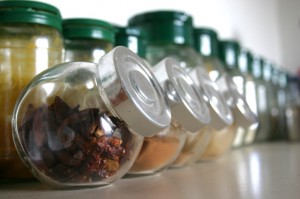
Angel Lior via FreeImages.com
Substituting Dried Herbs for Fresh Herbs
Since dried herbs possess a stronger flavor than fresh leaf herbs, you will need to adjust your habits when adding dried herbs to a recipe that calls for fresh herbs. Simply substitute 1/3 of the amount to adjust the strength in taste. You don’t want your final results to carry an overpowering favor. Also, there are some dishes that just require fresh — those whose main ingredient is an herb just don’t taste right when made with dried herbs.
Better Flavor Release
When cooking with dried herbs, crushing them in the palm of your hand (or between your fingers) will release more of the flavor more quickly. This works well with strong-flavored herbs, such as rosemary and sage. Combining a strong-flavored seasoning with a couple of mild-flavored ones is a good way to balance out the flavor in a recipe you feel is too strong in taste.
To get the most flavors out of your dried herbs, I suggest you purchase the whole herb leaves rather than ground or powdered selections. This is because they are able to hold their flavor longer when stored. Before using, pulverizing the dried herb leaves will effectively release their flavor.
Substituting Whole Spices for Ground Spices
If you should need to substitute a whole spice for a ground spice, you should use 1-1/4 times as much as the recipe suggests. In the case of doubling a recipe, the herbs and spices should not be doubled. Instead, increase them by 1-1/2 times and then taste for preference — adding more as needed.
Seasoned Meal Limits
When preparing dinner, it is highly suggested not to season more than one dish using the same herb. As you arrange your menu, a good rule of thumb to follow is to refrain from using herbs in all of your dishes. Two or three is good enough, but not necessary.
Limit Strong-Flavored Herbs
When preparing your dishes, use only one strong-flavored herb at a time per meal. Examples of these kinds of herbs include rosemary, tarragon, sage, marjoram, thyme, basil, mint and dill. Despite this limitation, it is still OK to combine a strong-flavored herb with an assortment of mild-flavored selections, such as parsley or chives.
Grinding and Crushing Herb and Spices
When preparing a dish, the grinding or crushing of herbs and spices should take place immediately before cooking so that the best level of aromatic flavor is released, causing the flavor of a dish to truly blossom.
Mortar and Pestle
One of the best tools for crushing a small amount of herbs or spices is the mortar and pestle, which provides quick use and allows cooks to control the coarseness of the grind. I use one made of marble and just love it. But I have used wooden ones, as well. On thought though, if you use your mortar and pestle to crush garlic, don’t use wood — the strong odor and flavor is absorbed by the wood and will affect other things you crush in the mortar.
Spice Mill or Coffee Grinder
If you tend to prepare a large amount of herbs and spices, you might want to invest in a spice mill or coffee grinder. It makes the task much more convenient and quick.
Using Spices for Baked Goods
If you grind your own spices for baked goods recipes, be sure to sift them before using to eliminate any “woody” bits and pieces.

